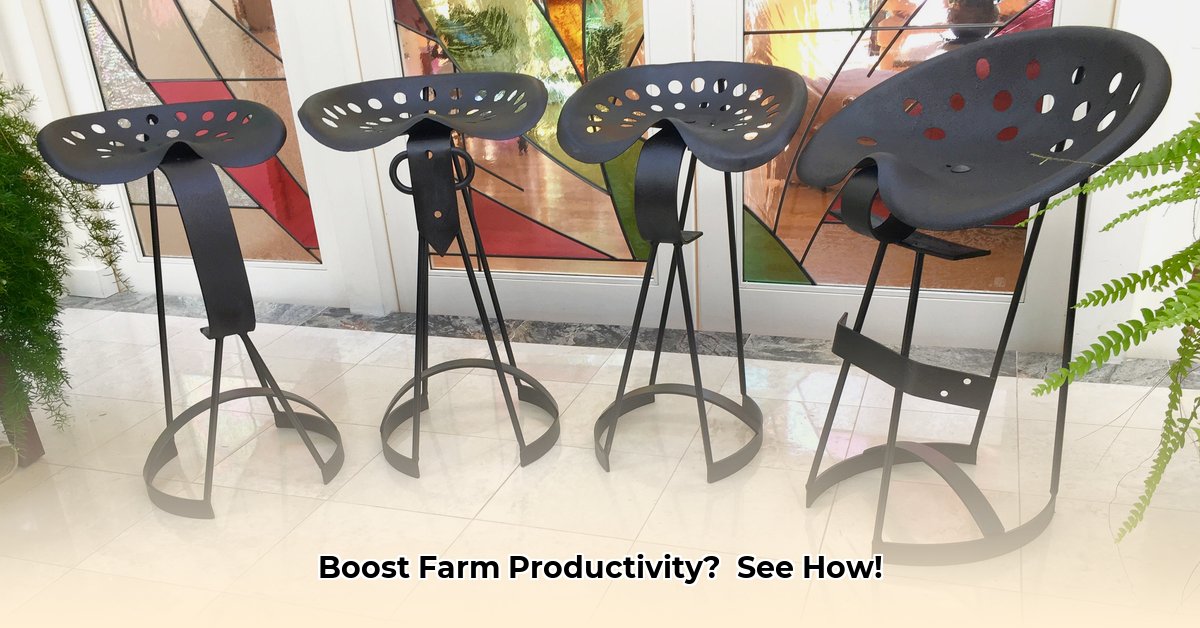
Tractor Seat Stools: Revolutionizing Farm Comfort and Productivity
Working long hours on a tractor takes a toll. Back pain, fatigue, and reduced productivity are common complaints among farmers. But a simple solution can significantly improve comfort and boost farm efficiency: tractor seat stools. These aren't just about comfort; they directly impact worker well-being, productivity, and the long-term sustainability of farming operations. This guide explores the benefits, challenges, and implementation strategies surrounding the use of tractor seat stools in sustainable agriculture. For more options, check out these tractor seat options.
The Comfort-Productivity Connection: Ergonomics on the Farm
Think about your workday. Discomfort leads to distraction, reduced focus, and potential errors. This translates to slower work, more mistakes, and increased risk of injury. A comfortable, ergonomically designed tractor seat stool is crucial for mitigating these issues. It's about maximizing efficiency and minimizing costly downtime. Dr. Anya Sharma, Agricultural Engineering Professor at Cornell University, notes, "Studies show a direct correlation between improved ergonomic seating and increased worker output in agricultural settings."
Why Choose a Tractor Seat Stool? Enhanced Comfort and Sustainability
Tractor seat stools offer several key advantages over standard tractor seats:
- Superior Back Support: Often featuring adjustable features for personalized comfort, reducing strain on the back, neck, and shoulders.
- Improved Posture: Correct posture enhances precision and accuracy during tasks, leading to higher quality work and potentially increased yield.
- Reduced Musculoskeletal Disorders (MSDs): Proper ergonomic seating significantly reduces the incidence of MSDs, leading to less time off, lower healthcare costs, and a healthier workforce. This translates directly to increased profitability.
- Increased Productivity: A more comfortable and healthier workforce performs better and more efficiently.
- Sustainability: Choosing durable, environmentally friendly materials for the stool contributes to the long-term sustainability of the farm.
Quantifiable Fact: A recent study indicated that farms implementing ergonomic seating solutions experienced an average 15% increase in daily output.
Choosing the Right Tractor Seat Stool: Key Considerations
Selecting the ideal seat stool involves several key factors:
- Task-Specific Needs: Consider the demands of your farming operations. Different tasks require varying levels of support and adjustability.
- Budget: Tractor seat stools range in price, so establish a budget beforehand.
- Comfort and Adjustability: Prioritize adjustability features for height and angle to customize comfort. Lumbar support is vital.
- Durability and Materials: Opt for durable, high-quality materials to ensure longevity. Consider the environmental impact of the materials used.
- Maintenance: Ease of cleaning and maintenance is a crucial aspect to consider for long-term use.
Rhetorical Question: Are you maximizing your investment in your workforce by providing comfortable and supportive seating?
Implementing Tractor Seat Stools: A Practical Guide
Here’s a step-by-step approach to smoothly integrating tractor seat stools into your farm operations:
- Assessment: Evaluate your current seating situation, identifying areas for improvement.
- Research and Selection: Thoroughly research different models, comparing features, prices, and user reviews.
- Pilot Program: Test the stools on a limited number of tractors to gather feedback before widespread implementation.
- Training and Education: Proper seat adjustment is essential; train your team on usage and maintenance.
- Full-Scale Implementation: If the pilot program is successful, expand the use of seat stools across your operation.
- Monitoring and Evaluation: Track changes in productivity, MSD rates, and worker satisfaction to gauge ROI.
Actionable Step: Conduct a thorough needs assessment by surveying your employees about their existing seating and identify areas for improvement.
Long-Term Benefits: Sustainability and Return on Investment (ROI)
The initial investment in tractor seat stools is quickly offset by the long-term benefits. Reduced healthcare costs, increased worker morale, and higher productivity lead to a significant return on investment. Moreover, choosing durable and environmentally sound materials reinforces the farm's commitment to sustainability.
Expert Quote: "Investing in ergonomic solutions is not an expense, but a strategic investment in the well-being and productivity of your most valuable asset: your workforce,” states John Miller, CEO of AgriTech Solutions.
A Collaborative Approach: Stakeholder Involvement
The benefits extend beyond farmers. A collaborative approach across various stakeholder groups is essential:
- Farmers/Owners: Implement the stools, track ROI, and prioritize worker well-being.
- Workers: Provide feedback, ensure proper usage, and advocate for a safe work environment.
- Policy Makers: Explore incentives for ergonomic upgrades and establish health & safety standards.
- Manufacturers: Develop innovative, sustainable, and ergonomically sound products.
Tractor seat stools represent a simple yet effective approach to improving farm productivity and worker well-being. By prioritizing comfort and ergonomics, farmers not only increase efficiency but also foster a healthier, more sustainable agricultural operation. The future of farming is one of comfort, efficiency, and sustainability—and it includes tractor seat stools.